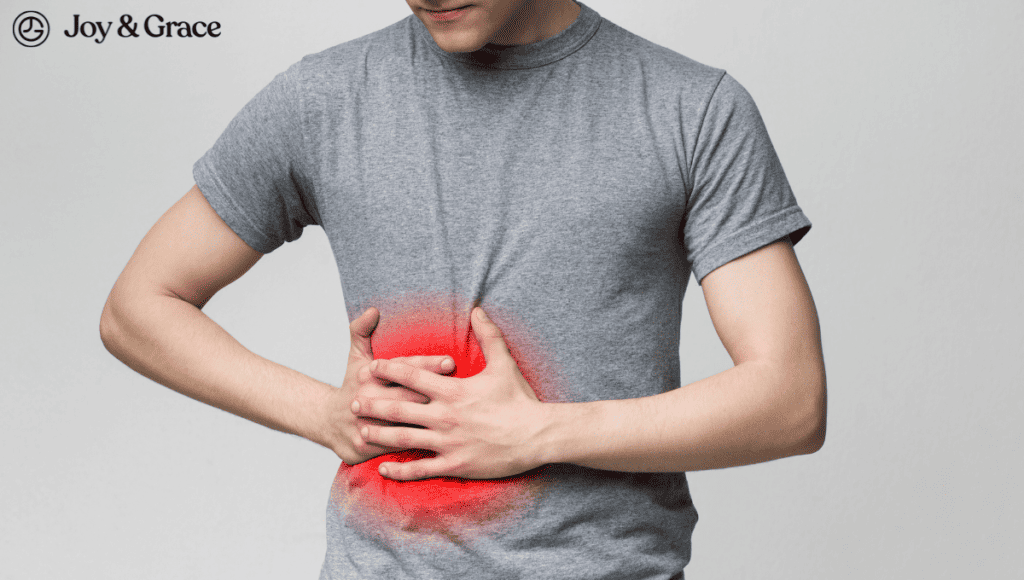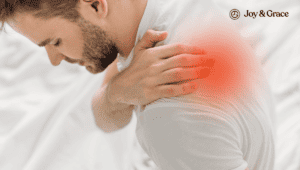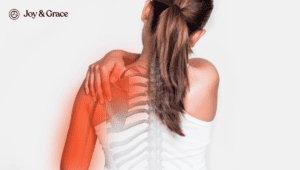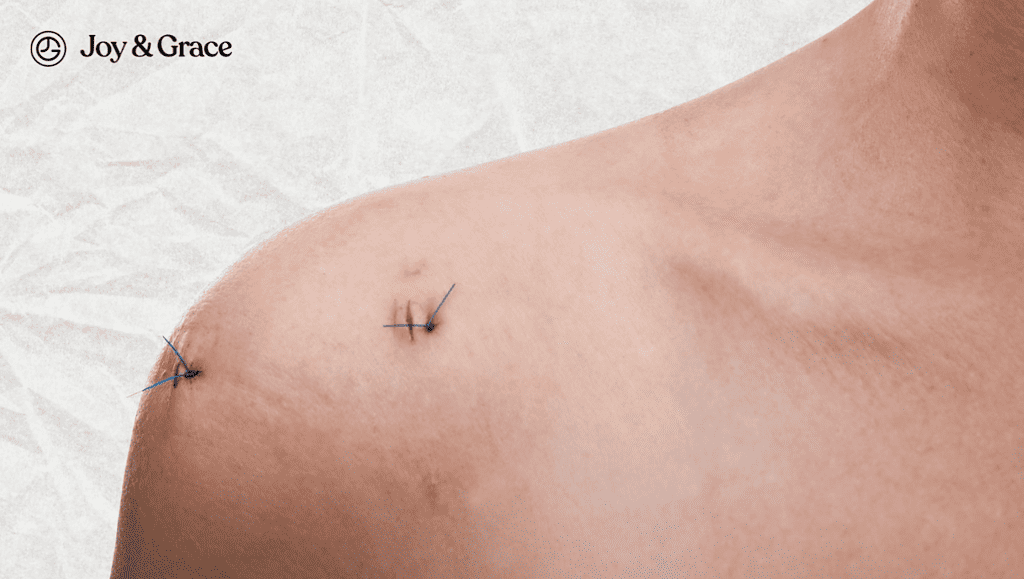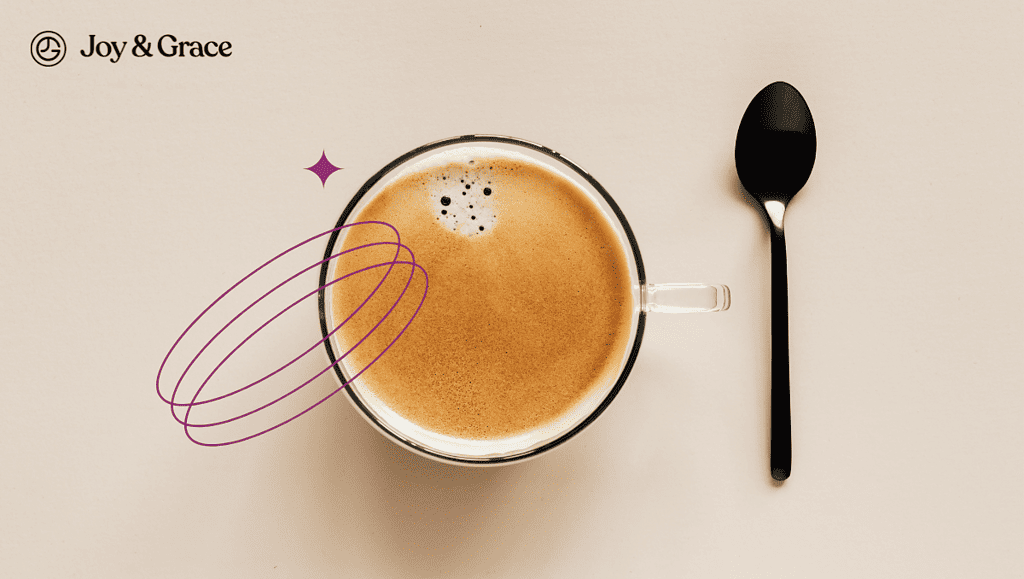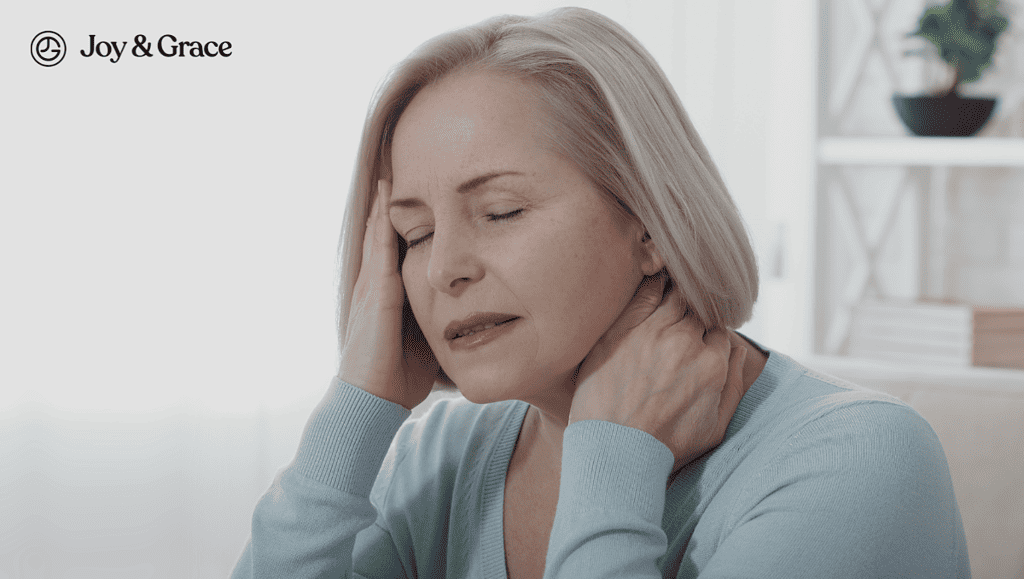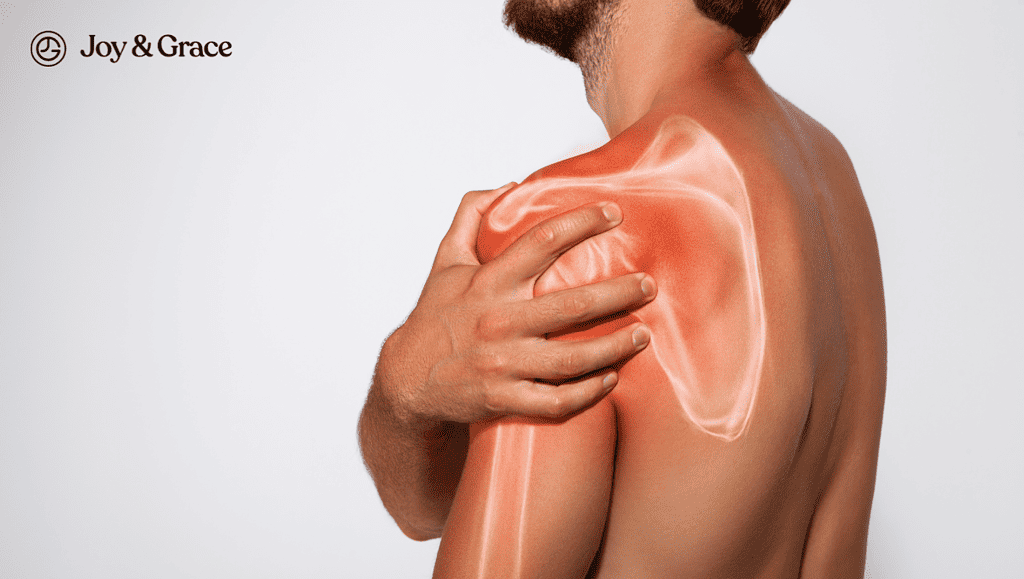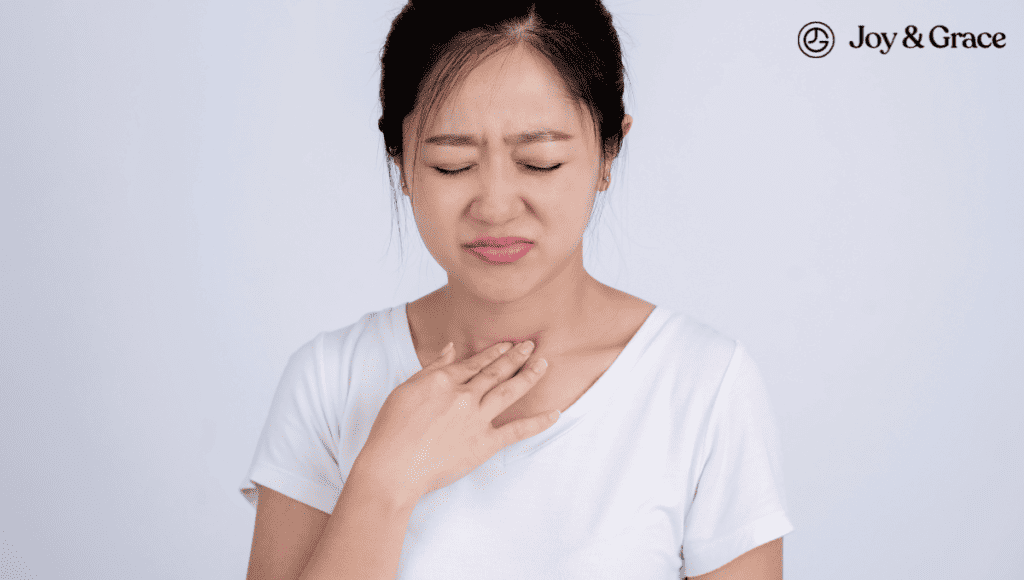Shoulder pain is often put down to strain or poor posture, but sometimes the cause can be less obvious. What are the chances that this pain could actually be signaling a gallbladder problem? Let’s take a closer look at this intriguing possibility.
Can Gallbladder Problems Cause Shoulder Pain?
Yes, gallbladder problems can lead to shoulder pain. Due to its position, the gallbladder usually causes pain near the (right) shoulder blade rather than at the front of the shoulder.
However, it's rare for shoulder pain to be the sole symptom of gallbladder issues.
There are a few other more common reasons why people get shoulder pain that you should also consider. Some of these common causes include:
- Rotator cuff tendonitis or tendinopathy:
This is inflammation or irritation of the rotator cuff tendons. Overuse, repetitive physical activities, or aging most commonly cause it.
- Rotator cuff tears:
These are partial or complete tears in the tendons of the rotator cuff. Trauma or everyday wear and tear are common causes of them.
- Shoulder impingement syndrome:
This is compression or pinching of the tendons and bursa in the shoulder joint. Poor posture or repetitive overhead activities are frequent causes of it.
- Adhesive capsulitis (frozen shoulder):
Frozen shoulder is characterized by stiffness and limited range of motion in the shoulder joint. It is often associated with inflammation and thickening of the joint tissue.
- Shoulder osteoarthritis:
This happens when the cartilage in the shoulder joint breaks down over time. It can lead to shoulder pain, stiffness, and a reduced ability to move the shoulder.
- Bursitis:
Bursitis means inflammation of the bursa. Bursas are fluid-filled sacs around joints. They are a type of connective tissue that cushions the bones, tendons, and muscles around the shoulder joint.
- Shoulder instability:
Shoulder instability occurs when the shoulder joint partially (shoulder subluxation) or fully slips out of place (shoulder dislocation). It often happens due to loose ligaments or an injury.
- Shoulder fractures:
Shoulder fractures are breaks in the bones of the shoulder, such as the clavicle (collarbone) or humerus (upper arm bone).
- Tendon tears or ruptures:
Tears or ruptures in the shoulder tendons, such as the biceps tendon - Septic Arthritis (Shoulder joint infection):
This is when the shoulder joint gets infected. It can cause pain, swelling, and limited range of motion.
Does Gallbladder Cause Left or Right Shoulder Pain?
Pain from gallbladder issues can indeed sometimes spread to your right shoulder blade.
But, as previously mentioned, this is often a radiating pain from the upper right part of your belly. Gallbladder issues don’t typically present with sole shoulder pain as their main symptom.
So, if you're feeling pain solely in your shoulder without any other symptoms indicating gallbladder disease, then it's unlikely that the gallbladder is to blame.
Here's a quick summary of symptoms associated with gallbladder issues.
Gallbladder Disease Symptoms
Gallbladder disease encompasses various health conditions that can affect the gallbladder. The symptoms can vary depending on the specific condition and its severity. Here are some common symptoms associated with gallbladder disease:
Abdominal Pain:
Abdominal pain is the most common symptom of gallbladder disease. It typically occurs in the upper right part of the abdomen, but it can also be felt on the middle or left side in some cases. The pain is described as a gripping or gnawing sensation. It can last from minutes to hours. It may radiate to the back or right shoulder blade.
Nausea and Vomiting:
Many individuals with gallbladder disease experience nausea and may vomit. The symptoms may be triggered or worsened by eating fatty or greasy foods.
Indigestion and Bloating:
Gallbladder disease can cause indigestion. This is characterized by fullness, discomfort, or bloating after eating. Some individuals may also experience excessive gas or belching.
Fever and Chills:
In cases of acute cholecystitis (gallbladder inflammation), a bacterial infection may occur. This can lead to symptoms such as fever, chills, and an overall feeling of sickness.
Jaundice:
If a gallstone blocks the bile duct, it can cause a buildup of bilirubin (a yellow pigment) in the bloodstream. Jaundice, characterized by yellowing skin and eyes, can result from this.
Changes in Bowel Movements:
Gallbladder disease can sometimes lead to changes in bowel movements.
This may include diarrhea or loose stools, especially after consuming fatty or greasy foods. The stool may also be pale. Urine may be dark.
It's important to note that not everyone with gallbladder disease will experience all of these symptoms, and the severity can vary.
If you are experiencing persistent symptoms, it's advisable to consult a healthcare professional. They'll provide an accurate diagnosis and appropriate treatment.
Where Is Gallbladder Shoulder Pain Located?
Gallbladder shoulder pain is typically felt in the upper back near the right shoulder blade.
The gallbladder is situated in the upper right abdomen. Hence, when it's troubled, the pain can radiate to the upper back and right shoulder blade due to its proximity.
This is known as referred pain, where pain originating from one area is felt in another area of the body.
It’s important to note that not all gallbladder diseases cause shoulder pain. Only specific types that cause gallbladder inflammation lead to this radiating discomfort.
Inflammation of the gallbladder is called cholecystitis ("cholecyst"—gallbladder, "itis"—inflammation).
Causes Of Acute Cholecystitis
Causes of acute cholecystitis include:
- Gallstones
Gallstones most commonly cause gallbladder duct inflammation. These are hardened deposits of bile components such as cholesterol and bilirubin. When these components remain in the gallbladder and solidify, they can form gallstones. - Biliary sludge
If the gallbladder doesn't empty all the way, cholesterol or calcium salts in the bile can get thicker because they've been in the gallbladder for too long. They eventually become biliary sludge. Biliary sludge can lead to the blockage of the cystic duct and result in acute cholecystitis.
Gallstones and biliary sludge account for 95% of all acute cholecystitis cases. - Hormonal factors:
Hormonal factors include pregnancy or hormone therapy (such as birth control pills). They can increase the risk of developing acute cholecystitis. - Gaining or losing weight rapidly:
Significant weight loss or gain can contribute to the development of acute cholecystitis. - Strictures:
Bile duct strictures are narrowings or blockages in the tubes that carry bile from the liver to the small intestine. Risk factors include gallstones, inflammation, trauma, infections, and certain medical procedures. Complications may lead to jaundice, liver damage, and infection. - Serious illness or trauma:
Acute cholecystitis can develop as a complication of severe illness or trauma. Examples of trauma include burns, major surgery, or severe infections. - Infection:
Bacterial infection in the bile duct system can cause inflammation and lead to acute cholecystitis. - Tumors:
Tumors in the gallbladder, bile ducts, or surrounding structures can cause obstruction. This leads to acute cholecystitis. Gallbladder tumors are considered a rare occurrence.
What Does Gallbladder Shoulder Pain Feel Like?
Gallbladder shoulder pain is typically a sharp pain that feels like gripping or gnawing discomfort in the upper right abdomen near the rib cage.
The pain can also feel “dull” to some people.
This severe pain can radiate to the upper back and shoulder blade area, particularly the right shoulder.
As we've said, this pain often comes with other issues like nausea or an upset stomach. If you don't have these additional symptoms, the pain might be from something else.
Why Is Gallbladder Pain Referred to Shoulder?
When the gallbladder is upset, it can irritate a nearby nerve called the phrenic nerve.
This nerve connects to areas around the shoulder. So, the brain gets mixed signals and sometimes thinks the pain is coming from the shoulder, even when it's actually from the gallbladder. It's like getting a crossed wire in a phone connection!
Another way of describing this mechanism is by mentioning the main players behind this play:
1. Sensory (“feel”) Nerves:
The gallbladder has sensory nerve fibers that transmit signals related to pain. Some of these fibers are carried by the phrenic nerve, which powers the diaphragm.
2. Nerve Pathways:
The sensory nerves from the gallbladder and the shoulder region converge and share common nerve pathways.
3. Spinal Cord:
The sensory nerves carrying pain signals from the gallbladder enter the spinal cord through specific levels.
4. Central Nervous System (CNS):
The pain signals travel to the brain through upward pathways from the spinal cord. The brain receives and interprets these signals, leading to pain perception in the referred shoulder area.
How Do You Know if Shoulder Pain Is From Gallbladder?
Shoulder pain can have various causes, and as we mentioned earlier, gallbladder issues rarely cause shoulder (blade) pain alone.
So, if the shoulder pain is caused by the gallbladder, other common signs often show up, such as:
- Upset Stomach: Nausea or vomiting, especially after eating fatty foods.
- Belly Pain: A steady, gripping, or gnawing pain in the upper right area of your stomach, near the rib cage.
- Fever or Chills: These symptoms may suggest inflammation, possibly associated with a gallbladder infection.
- Jaundice: A yellowing of the skin or eyes, pointing to liver involvement.
If your shoulder pain comes with any of these signs, it might be time to consult a doctor about your gallbladder.
If you’re worried you might have gallbladder issues, it's a good idea to reach out to a healthcare professional. They're the experts who can diagnose you accurately and determine the best treatment for you. Don't worry. They've got your back (or, in this case, your shoulder)!
Can Gallstones Cause Pain in Both Shoulders?
No, gallstones are not known to cause pain in both shoulders.
Gallstones are small, solid deposits that form in the gallbladder, which is located in the upper right quadrant of the abdomen.
In fact, gallstones don’t even cause any symptoms in most cases.
Symptoms only appear when the stones obstruct the bile ducts and cause gallbladder inflammation.
The pain associated with gallstones is known as biliary colic, and it is usually felt in the upper right or middle part of the abdomen.
Because of this proximity, it is more common for gallstone-related pain to be felt in the upper back near the right shoulder blade, as we discussed earlier.
Does Shoulder Pain Go Away After Gallbladder Removal?
If the shoulder pain is gallbladder-related, then yes, it does go away most of the time after the gallbladder is removed.
However, research indicates that it can briefly persist after laparoscopic cholecystectomy. A cholecystectomy is a procedure where doctors remove your gallbladder. Shoulder pain is a common complaint following laparoscopic cholecystectomy.
Laparoscopic Cholecystectomy
This procedure is minimally invasive. They make a few small incisions in your abdomen and insert a thin tube with a camera called a laparoscope.
The surgeon uses special tools to remove the gallbladder through these tiny incisions. It's a popular choice because it has a shorter recovery time and leaves smaller scars.
Shoulder pain is a common complaint following laparoscopic surgery in general. Of note is that this pain is usually transient.
This is due to residual carbon dioxide gas in the abdomen or nerve compression during surgery.
Research has shown that shoulder tip pain after this surgery varies greatly. Some studies report incidences as high as 30–50%.
How to Relieve Gallbladder Shoulder Pain?
To relieve gallbladder shoulder pain, it's essential to address the root cause, which is gallbladder inflammation.
If you have shoulder pain along with gallbladder disease symptoms, consult a health care professional immediately.
Here's a brief overview of the measures healthcare providers may recommend:
Management of Acute Cholecystitis:
1. Mild, uncomplicated cases:
Mild and uncomplicated cases of acute cholecystitis can often be treated on an “outpatient” basis. Outpatient means treatment is outside the hospital. Let's review some treatments you can use at home:
- Medications:
Over-the-counter pain relievers such as ibuprofen can help reduce the pain.
- Heat Therapy:
Applying heat to the affected area can relieve gallbladder and shoulder pain. You can use a heating pad or take a warm bath to relax the muscles and alleviate discomfort. Be cautious not to apply excessive heat that could cause burns.
- Dietary Changes:
Making changes to your diet may help manage gallbladder and shoulder pain. Avoiding fatty or greasy foods can reduce the workload on the gallbladder and decrease the intensity of the pain. Opt for a healthy diet rich in fruits, vegetables, whole grains, and lean proteins. Consulting with a registered dietitian can provide personalized recommendations.
- Lifestyle Modifications:
Engaging in regular physical activity and maintaining a healthy weight can help alleviate gallbladder and shoulder pain. Exercise helps improve digestion and promotes overall well-being. Talk to your doctor before starting a new exercise program.
Moderate cholecystitis may need to be treated at a hospital, as outlined below.
2. Initial Hospital Treatment for Acute Cholecystitis:
For more severe cases of acute cholecystitis, the first line of treatment in a hospital setting typically includes various approaches to reduce symptoms and support the patient's health:
- Bowel rest is recommended, which means avoiding solid foods and sticking to a clear, liquid diet.
- Intravenous (IV) hydration is provided. It is used to maintain fluid balance and correct any electrolyte abnormalities.
- Analgesia, or pain relief, is administered to help manage the abdominal pain. IV antibiotics are given to fight the infection in the gallbladder.
3. Surgical Options:
Sometimes, the condition does not improve with conservative management, or complications arise.
In these cases, surgical intervention may be necessary. The following are the types of surgery that can be done:
- Laparoscopic cholecystectomy:
This is a minimally invasive surgical procedure. It involves removing the gallbladder through small incisions in the abdomen.
- Percutaneous gallbladder drainage/cholecystostomy:
This is a procedure where a tube is inserted through the skin and into the gallbladder to drain the infected fluid.
- Endoscopic gallbladder drainage:
This is another option where a flexible tube is inserted through the mouth and into the small intestine to drain the gallbladder.
Bonus Information: How Are Gallbladder Issues Diagnosed?
1. Physical examination
This may reveal fever, pain in the right upper abdomen or epigastric region.
2. Blood Tests for Gallbladder Disease
Blood tests are commonly used to assess the presence and severity of gallbladder disease. These tests can provide valuable information about the functioning of the liver and gallbladder. Here are the main laboratory tests used to evaluate gallbladder disease:
- Higher White Blood Cell Count with Immature Cells
This means the blood has too many white blood cells, and a lot of them are not fully developed. It's a sign that the body might be fighting an infection or inflammation, like what happens with gallbladder disease.
- Elevated Liver Enzymes (ALT, AST):
This means that if the levels of certain liver enzymes (like ALT and AST) are high in the blood, it could be a sign of liver damage or inflammation. This might be related to gallbladder disease.
- Elevated Bilirubin:
Bilirubin is a yellow pigment produced during the breakdown of red blood cells. Elevated levels of bilirubin in the blood can indicate liver or gallbladder dysfunction.
- Elevated Alkaline Phosphatase (ALP):
Alkaline phosphatase is an enzyme found in various tissues, including the liver and bones. Elevated levels of ALP in the blood can indicate liver dysfunction. In cases of gallbladder disease, high ALP levels might mean the bile ducts are blocked.
- Potentially Elevated Amylase:
The pancreas and salivary glands both produce the enzyme Amylase.
Elevated amylase levels are not specific to gallbladder disease. They can be seen in cases where the inflammation or obstruction of the gallbladder affects the pancreas.
3. Imaging Tests for Gallbladder Disease
In addition to laboratory tests, imaging is often used to diagnose gallbladder disease. These imaging techniques allow healthcare professionals to visualize the gallbladder and surrounding structures. Here are the main imaging tests used for diagnosing gallbladder disease:
- Ultrasound (US):
Ultrasound is a non-invasive imaging technique. It uses sound waves to create images of the gallbladder and other abdominal organs. Ultrasound is often the first imaging choice for checking gallbladder disease because it's easy to use, safe, and good at finding gallstones.
- Computed Tomography (CT):
CT scans use X-rays and computer processing to create detailed cross-sectional images of the body. CT scans can provide more detailed information about the gallbladder. They are especially helpful for checking for disease complications like abscesses or a perforated gallbladder.
- Magnetic Resonance Imaging (MRI):
MRI uses a magnetic field and radio waves to create detailed body images. MRI can provide high-resolution images of the gallbladder and bile ducts. It is particularly useful for evaluating the biliary system and detecting small stones that may be missed on ultrasound.
- Hepatobiliary Isotope Scintigraphy
The HIDA scan, which injects a radioactive tracer into the blood, lets doctors see the liver, gallbladder, and bile ducts. It checks how well the gallbladder works and finds any blockages.
- Endoscopic Retrograde Cholangiopancreatography (ERCP):
ERCP is a procedure that can both diagnose and treat problems in the bile and pancreatic ducts. It uses a flexible tube put through the mouth down to the small intestine, and a special dye is injected to make the gallbladder and bile ducts show up clearly on X-rays.
Takeaway
Shoulder pain can be a bothersome and limiting issue that affects many individuals. While gallbladder disease is not a common cause of isolated shoulder pain, it is important to consider other more common causes, such as:
- Rotator cuff tendonitis, shoulder impingement syndrome,
- adhesive capsulitis,
- shoulder osteoarthritis.
Gallbladder disease typically causes pain in the upper right part of the abdomen. This pain can sometimes radiate to the upper back and near the right shoulder blade. It is not likely to be the main cause, though, if you only have shoulder pain and no other signs of gallbladder disease.
If you suspect gallbladder disease, it is important to be aware of the associated symptoms, such as:
- abdominal pain,
- nausea and vomiting,
- indigestion and bloating,
- fever and chills,
- jaundice,
- changes in bowel movements.
These symptoms can help differentiate gallbladder-related shoulder pain from other causes.
Shoulder pain usually resolves after the surgical removal of the gallbladder (cholecystectomy). However, in some cases, shoulder pain can persist after laparoscopic cholecystectomy.
Treatments such as medications, heat therapy, dietary changes, and lifestyle modifications can be used. In severe cases, medical interventions like cholecystectomy may be recommended.
Remember, self-diagnosing is never a good idea. Rely on the expertise of medical professionals. They'll help you get to the bottom of this unusual connection between your shoulder and gallbladder. In the meantime, stay positive and stay curious!
